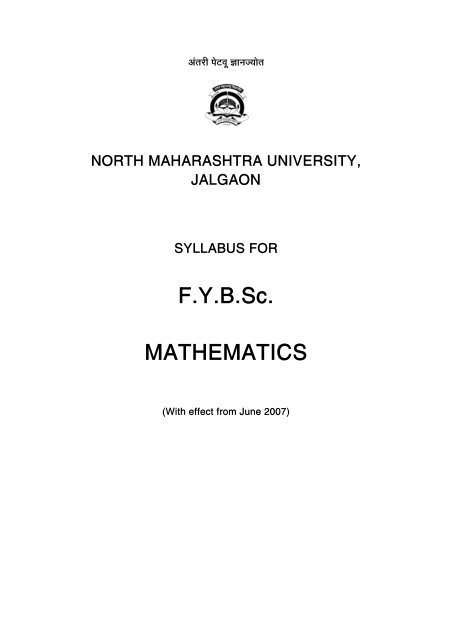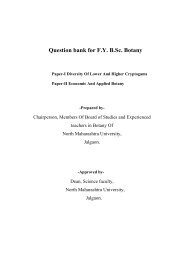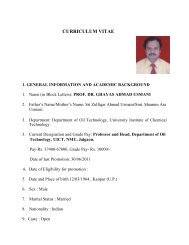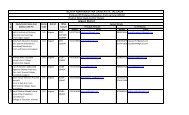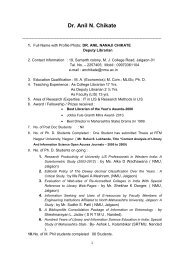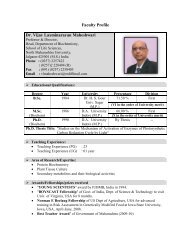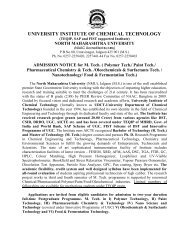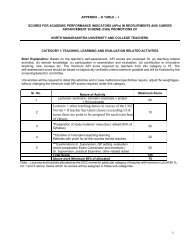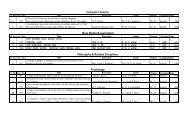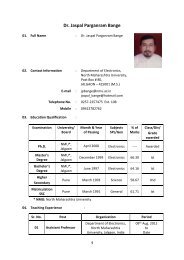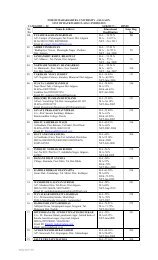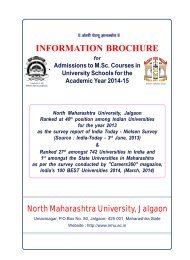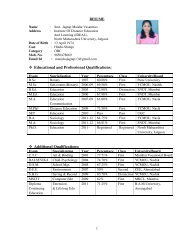F.Y.B.Sc. MATHEMATICS - North Maharashtra University
F.Y.B.Sc. MATHEMATICS - North Maharashtra University
F.Y.B.Sc. MATHEMATICS - North Maharashtra University
You also want an ePaper? Increase the reach of your titles
YUMPU automatically turns print PDFs into web optimized ePapers that Google loves.
†ÓŸÖ¸üß ¯Öêü¾Öæ –ÖÖ−Ö•μÖÖêŸÖNORTH MAHARASHTRA UNIVERSITY,JALGAONSYLLABUS FORF.Y.B.<strong>Sc</strong>.<strong>MATHEMATICS</strong>(With effect from June 2007)
||†ÓŸÖ¸üß ¯Öêü¾Öæ –ÖÖ−Ö•μÖÖêŸÖ ||****(NAAC ACCREDITED)<strong>North</strong> <strong>Maharashtra</strong> <strong>University</strong>,JalgaonSyllabus for F.Y.B.<strong>Sc</strong>.Subject: - MathematicsWith Effect from June 2007Paper I : Algebra and Trigonometry.Code No.:Paper II : Calculus.Code No.:Paper III (A) : Vector Analysis and Geometry. Code No.:ORPaper III (B) : Discrete Mathematics.Code No.:
||†ÓŸÖ¸üß ¯Öêü¾Öæ –ÖÖ−Ö•μÖÖêŸÖ||2NORTH MAHARASHTRA UNIVERSITY, JALGAONIntroduction:Syllabus for F.Y.B.<strong>Sc</strong>.Subject : <strong>MATHEMATICS</strong>.(With effect from June 2007)The Authority of <strong>North</strong> <strong>Maharashtra</strong> <strong>University</strong> decided to change the syllabiof various faculties from June,2007. The knowledge of <strong>Sc</strong>ience and Technology ischanging day by day rapidly. New approaches in different areas of Mathematics andrelated subjects are developing every day. Taking into consideration the Board ofstudies in Mathematics with concern of teachers of Mathematics from differentcolleges affiliated to <strong>North</strong> <strong>Maharashtra</strong> <strong>University</strong> and also teachers from otheruniversities, have prepared the syllabus. The U.G.C. Model curriculum given byU.G.C. is used.Aims and Objectives:There are different branches like Computer <strong>Sc</strong>ience, Electronics, Physics,Statistics, Biotechnology, Finance, Engineering etc. The aim to set the syllabus is thatstudents can overcome the difficulties relating to these branches and can study anysubject at research level. Also the aim is to give the sufficient knowledge of basicconcepts in Mathematics required for higher studies in Mathematics.Objectives:(i)(ii)(iii)(iv)(v)To provide students adequate background of Mathematical tools andtechniques.To Provide students adequate exposure to global and local concernsthat explore them many aspects of Mathematical <strong>Sc</strong>iences.To permit students an opportunity to explore the multidisplinary in<strong>Sc</strong>ience, particularly in those emerging areas that lie in the intersectionof Physical, Chemical, Life and Earth <strong>Sc</strong>iences.To provide adequate knowledge of Mathematics to face differentcompetitive examinations.To provide sufficient knowledge of Basic Mathematics require forhigher studies in Mathematics.
||†ÓŸÖ¸üß ¯Öêü¾Öæ –ÖÖ−Ö•μÖÖêŸÖ ||3****(NAAC ACCREDITED)<strong>North</strong> <strong>Maharashtra</strong> <strong>University</strong>, JalgaonF.Y.B.<strong>Sc</strong>.<strong>MATHEMATICS</strong> SYLLABUS(With Effect from June 2007)PAPER I: ALGEBRA AND TRIGONOMETRY.UNIT-I: Marks: 16 Periods: 16Elementary operations on matrices, Adjoint of matrix, Inverse of the matrix,Existence uniqueness and properties of the inverse. Elementary matrix, Rank of thematrix. Normal form of matrix, Reduction of matrix to its normal form. Rank of theproduct of two matrices.Eigen values, Eigen vectors, characteristic equation of matrix. CayleyHamilton Theorem and its use to find the inverse of matrix.UNIT-II: Marks: 16 Periods: 16Application of matrices to system of linear equations (both homogeneous andnon-homogeneous equations). Consistency of system of linear equations.Relation between roots and coefficient of general polynomial equation in onevariable. Symmetric function of roots. Transformation of equations. Descartes’ ruleof signs. Cardon’s method of solving cubic equations. Biquadratic equations.UNIT-III: Marks: 16 Periods: 16Relations, Equivalence relations, partitions congruence modulo n, Residueclasses.Groups: Definition of group, simple properties of group. Abelian group. Finite andInfinite groups. Order of the group. Order of an element and its properties.UNIT-IV: Marks: 16 Periods :16Subgroups. Definition and criteria for a subset to be subgroup. Cyclic groups.Coset decomposition. Lagranges theorem for Finite group. Fermat’s Theorem.Euler’s Theorem.
4UNIT-V: Marks:16 Periods :16De-moivre’s Theorem and its Applications. Direct and Inverse circular andhyperbolic functions. Logarithm of complex quantity. Expansion of trigonometricfunctions.REFERENCES :1. I.N. Herstein, Topics in Algebra, Wiley Eastern Ltd. New Delhi, 1975.2. K.B.Datta, Matrix and Linear Algebra, Prentice Hall of India Pvt.Ltd. NewDelhi,2000.3. P.B.Bhattacharya, S.K.Jain And S.R.Nagpaul, First Course in Linear Algebra,Wiley Eastern, New Delhi,1983.4. H.S.Hall and S.R.Knight, Higher Algebra, H. M. Publication, 1994.5. Chandrika Prasad, Text-Book on Algebra and Theory of Equations,Pothishala Private Ltd. Allahabad.6. S.L.Loney, Plane Trigonometry Part-II, Macmillan and company, London.7. R.S.Verma and K.S.Shukla, Text Book on Trigonometry, Pothishala PrivateLtd. Allahabad.PAPER II :CALCULUS.UNIT-I: Marks:16 Periods :16Epsilon-delta definition of limit of function. Basic properties of limits.Indeterminate forms, L’ Hospitals Rule. Continuous functions. Classification ofdiscontinuities. Properties of continuous functions on closed and bounded interual(i) Boundedness (ii) Attains its bounds (iii) Intermediate value theorem. Uniformcontinuity.Differentiability of function. Rolle’s Theorem. Lagranges Mean ValueTheorem. Cauchys Mean Value Theorem.UNIT-II: Marks:16 Periods :16Successive differentiation. The n th derivatives of some standard functions :e ax+b, (ax+b) m , x m 1, , log (ax+b), sin (ax+b), cos (ax+b), e ax sin (bx+c),e ax cos(bx+c)ax+bLeibnitz’s Theorem. Taylor’s Theorem Maclaurin’s Theorem.Asymptotes, curvature. Test for concavity and convexity. Points of inflexion.Multiple points. Tracing of Curves in Cartesian and polar co-coordinates.
5UNIT-III: Marks:16 Periods :16Integration of irrational algebraic and transcendental functions.Reduction formulae : (i) π/2 (i) π /2∫ sin n xdxo∫ cos n xdxo(iii π/2(iv)∫ sin m x cos n xdx ∫ sinnx dxosinxApplication of integration : Rectification, volume and surface of solid ofrevolution.UNIT-IV: Marks:16 Periods :16Differential Equations of first order first degree : Homogeneous differentialequations. Non-homogeneous differential equations. Exact differential equations.Condition for exactness. Integrating Factor. Rules for finding integrating factor.Linear differential equations and equations reducible to linear form.Differential equations of first order and higher degree solvable for x, y, p.clairaut’s form.UNIT-V: Marks:16 Periods :16Linear Differential Equations with constant coefficients. Complementaryfunctions. Particular Integrates of f(D)y = X. where X = e ax ,cosax, sinax, x n ,e ax V , xV with usual notations.Homogeneous Differential Equations and reducible to homogeneous differentialequations.REFERENCES :1. Murray R.Spiegel, Theory and Problems of Advanced calculus, <strong>Sc</strong>haum’soutline series, <strong>Sc</strong>haum Publishing co. New York2. N.Piskunov, Differential and Integral Calculus, Peace Publishers. Moscow.3. P.K.Jain and S.K.Kaushik, An Introduction to Real Analysis, S.Chand &co.New Delhi,2000.4. Gorakh Prasad, Intergral Calculus, Pothishala Private Ltd. Allahabad.5. Gorakh Prasad, Differential Calculus, Pothishala Private Ltd. Allahabad.6. D.A.Murray, Introductory course in Differential Equations, OrientLongman (India),1967.7. G.F.Simmons, Differential Equations, Tata McGraw Hill,1972.8. E.A.Codington, An Introduction to ordinary differential Equations,Prentice Hall of India,1961.
6PAPER III (A) : VECTOR ANALYSIS AND GEOMETRY.UNIT-I: Marks :16 Periods :16<strong>Sc</strong>alar and Vector product of three vectors Product of four vectors, reciprocalvectors.Vector function of single variable .Vector differentiation. Velocity,acceleration. Vector function of two and three variables. Partial differentiation.UNIT-II: Marks :16 Periods :16Gradient of scalar point function. Properties of gradient Directional derivativeof scalar point function. Divergence and curl of vector point function. Properties ofdivergence and curl. Vector Intergration (Line intergrals only).UNIT-III: Marks :16 Periods :16Analytical Plane Geometry : Change of axes. Translation and rotation.Invariants. Conic sections. General equation of second degree in two variables. Itsreduction to standard form.UNIT-IV: Marks:16 Periods :16Analytical geometry of three dimensions:Sphere : Equations of sphere in different forms. Plane section of sphere.Tangent line, Tangent plane to the sphere. Condition of tangency. Point of contact.Interpretation of s+ λs’=o and s+λU=o with usual notations. Relative position oftwo spheres and condition of tangency.UNIT-V: Marks:16 Periods :16Cones and cylinders. Their equations. Tangent plane at a point.Standard equations of conicoids, Tangent plane and normal line.REFERENCES :1. Murray R.Spiegel, Theory and Problems of Advanced calculus, <strong>Sc</strong>haumPublishing co. New York2. Murray R.Spiegel, Vector Analysis, <strong>Sc</strong>haum Publishing Company, NewYork3. Shanti Narayan, A Text Book of Vector Calculus, S.Chand and Co. NewDelhi.4. S.L.Loney,The Elements of Co-ordinate Geometry, Macmillan andCompany, London.5. Gorakh Prasad, and H.C.Gupta, Text Book on cor-ordinate Geometry,Pothishala Private Ltd. Allahabad.6. P.K.Jain and Khalil Ahmad,A Text Book of Analytical Geometry of TwoDimensions, Wiley Estern Ltd. 1994.
7. P.K.Jain and Khalil Ahmad,A Text Book of Analytical Geometry of ThreeDimensions, Wiley Estern Ltd. 1999.8. N. Saran and R.S.Gupta, Analytical Geometry of Three Dimensions,Pothishala Private Ltd. Allahabad.7PAPER III (B) : DISCRETE <strong>MATHEMATICS</strong>.UNIT-I: Marks:16 Periods :16Sets and propositions- Cardinality Mathematical Induction. Principle ofInclusion and exclusion.Computability and Formal Languages- orderd sets. Languages. PhraseStructure Grammars. Types of Grammars and Languages.UNIT-II: Marks:16 Periods :16Graphs and Planar Graphs- Basic Terminology. Multigraphs. WeightedGraphs. Paths and circuits. Shortest Paths. Eulerian Paths and circuits. TravellingSalesman Problem. Planar Graphs.UNIT-III: Marks:16 Periods :16Trees.Finite State Machines – Equivalent Machines. Finite State Machines asLanguage Recognizers.UNIT-IV: Marks :16 Periods :16Partial orderd Relations and Lattices, Chains and Antichains. Pigeon HolePrinciple.Analysis of Algorithms - Time complexity. Complexity of Problems.Discrete Numeric Functions and Generating Functions.UNIT-V: Marks :16 Periods :16Boolean Algebras- Lattices and Algebraic structures.Duality. Distributive and complemented Lattices.Boolean Lattices and Boolean Algebra. Boolean Functions and Expressions.RECOMMENDED TEXT :C.L.Liu, Elements of Discrete Mathematics (Second Edition), McGraw Hill,International Edition, Computer <strong>Sc</strong>ience series, 1986.======XXX======


